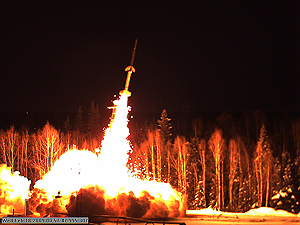Four rockets launch from Poker Flat Research Range
Four rockets launch from Poker Flat Research Range
Submitted by Amy Hartley
Phone: 907-474-5823
02/18/09

Four NASA rockets launched from Poker Flat Research Range during a three-hour span on the morning of Feb. 18, 2009. The rockets, carrying payloads that emitted glowing vapor trails that help scientists study turbulence in the upper atmosphere, launched at 12:59 a.m., 1:29 a.m., 1:59 a.m., and 2:49 a.m. Alaska Standard Time. The whitish trails, some resembling corkscrews in the sky, were visible in many parts of interior and northern Alaska.
"There were four trails on the up-leg (of the rocket trajectory), four on the down-leg," said Gerald Lehmacher of Clemson University, principal investigator for the experiment. "The instruments worked well."
The experiment featured four rockets--35-foot, two-stage Terrier Orions--that released two trails each of trimethyl aluminum nearly 87 miles up into the night sky.
"They pretty much filled up a big part of the sky," Lehmacher said.
The harmless vapor trails of the first rocket dissipated in about 20 minutes, after which Lehmacher and the launch crew sent following rockets into the same portion of the sky, which was clear with a faint arc of the aurora to the north. Researchers at ground stations in Fort Yukon, Coldfoot, and Toolik Lake captured images of the trails for later analyses.
With the experiment, known as "Turbopause," Lehmacher wants to learn more about turbulence in the upper atmosphere about 50 to 80 miles above our heads. Winds there can be much faster than those in the jet stream.
"We want to measure the region where turbulence reaches its largest values and then stops acting," Lehmacher said.
Lehmacher’s experiment was one of two set for February at Poker Flat. Next to launch is an experiment named Cascades II. Kristina Lynch of Dartmouth College is the principal investigator for the Cascades experiment, in which one 58-foot, four-stage Black Brant XII sounding rocket will blast off from Poker Flat into an active aurora display when the weather is clear above Chatanika and at camera sites in Toolik Lake and Kaktovik.
Poker Flat Research Range is the largest land-based sounding rocket range in the world. It’s located 30 miles north of Fairbanks on the Steese Highway. The Geophysical Institute at UAF operates the range under contract to NASA. More than 300 major scientific sounding rockets have launched from the facility since it was founded in 1969.
CONTACT: Poker Flat Research Range at 907-455-2110. Geophysical Institute science writer Ned Rozell at 907-474-7468 or nrozell@gi.alaska.edu
ON THE WEB: www.gi.alaska.edu/pfrr


